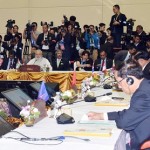An orthodox way of looking at India’s foreign policy is to see it as obsessed with “two-and-a-half countries”: United States, China and Pakistan. This completely ignores the fact that the nation’s foreign policy is anchored in a broad and expanding worldview, stretching from Fortaleza to Fiji. One of its major components is the policy towards East Asia, usually known as the ‘Act East’ Policy. Even as 2017 opens, this is the apt moment to reflect on its efficacy and what it can expect to achieve in the new year.
What also occasions this exercise now is that India’s dialogue partnership with ASEAN, which began in 1992, will complete 25 years this year. Likewise, its summit partnership, launched in 2002, and strategic partnership, established in 2012, are also set to complete 15 and five years respectively. The Indian government is likely to host a commemorative India-ASEAN summit later in the year, which will be preceded by an ambitious series of events and activities marking the historic milestone in the two sides’ journey together.
To comprehend and appreciate how India’s relationship with ASEAN and the larger East Asian region may evolve in the future, one needs to decode a term that figures in many analyses: “geopolitical environment.” A close look at developments in the region (and the world) since 2009, climaxing in the election of Donald Trump as the next U.S. president, sets a new stage in which several inter-state relationships will need to be examined afresh.
The region’s geopolitical dynamics will be largely moulded by four bilateral relationships and the well-being of one regional institution, ASEAN. Of the four relationships, the most important one is the U.S.-China equation. At the global level, the U.S. still retains its No 1 spot, but in Asia – especially East Asia – the perception is one of near parity between China, the challenger, and the U.S., the defending champion, a contest in which the latter has met with several setbacks.
It is in this backdrop of the Obama legacy that Trump enters the White House. The central question is whether the new administration will be tougher or softer on China. Scholars differ, for they have very little to go by except their own intuitive insights. Probably a likely scenario of uncertainty and unpredictability may prevail in which U.S.-China tensions could rise in the short term.
As for the U.S.-Japan relationship, one would rate high the prospect of it growing stronger because China’s assertive behaviour and the growing menace of North Korea as a nuclear weapons power, with fast expanding missile capacity, will impart a strong impetus to the Washington-Tokyo alliance.
The other two relationships are between India and China, and India and Japan. An objective view suggests that in the past two and a half years, the first has become strained, whereas the second has grown stronger. This trend became quite apparent in 2016, and will continue in the coming months. This makes it necessary for New Delhi to make a special effort to initiate a dialogue with the Trump team (which it has already done) and to sustain it politically so that India-U.S. cooperation gathers further momentum in the future.
As regards ASEAN, a glaring irony marked its voyage through 2016. At the year’s beginning, it turned itself with much fanfare, from an association into a community with three pillars: political-security, economic, and socio-cultural. But, on the other hand, in dealing with China and its continuing flouting of international law in respect of the South China Sea, ASEAN displayed its utter vulnerability and state of disarray. This trend may continue unless U.S., Japan and India work in unison to provide it strong support, thus empowering it to cope with the hegemon next door.
All this points to a clear conclusion: the Act East Policy needs to be further strengthened. Its strategic dimension and objective to enhance maritime security cooperation with interested ASEAN and extra-ASEAN powers should be accorded priority. While for diplomatic reasons, our faith in ‘ASEAN Unity and Centrality’ may remain unchanged and our participation in the plethora of its institutions may continue, New Delhi should pay higher attention to deepening and diversifying a few key bilateral relationships: Singapore, Malaysia and Vietnam, and Indonesia and Myanmar too.
India also needs to look more seriously at the existing agenda of cooperation, covered by the Act East Policy. Regional Comprehensive Economic Partnership (RCEP) negotiations should be brought to a swift conclusion in 2017, a goal that could not be met in 2016. Two initiatives launched by the Modi government, namely a special Line of Credit of $1 billion for connectivity projects with ASEAN countries, and a Special Purpose Vehicle of $100 million for industrial projects in CMLV countries, should be operationalised as soon as possible. The visibility of two institutions set up recently – ASEAN-India Centre, New Delhi and ASEAN Study Centre, Shillong – may be enhanced. As to the two flagship projects i.e. Trilateral Highway project and Kaladan Multi-modal Transport project, they, it is hoped, will be ready before the end of the decade.
Finally, recent feedback from the strategic community and media in our North-Eastern states indicates a continuing feeling of discontent over progress in forging links with Southeast Asia, particularly Myanmar. This needs to be addressed more effectively and holistically. The occasional car rally is welcome, but may not be enough.
Rajiv Bhatia is Distinguished Fellow, Foreign Studies Programme, Gateway House. He served as ambassador to Myanmar and as member of India-Indonesia Eminent Persons Group.
This article was exclusively written for Gateway House: Indian Council on Global Relations. You can read more exclusive content here.
For interview requests with the author, or for permission to republish, please contact outreach@gatewayhouse.in.
© Copyright 2016 Gateway House: Indian Council on Global Relations. All rights reserved. Any unauthorized copying or reproduction is strictly prohibited


